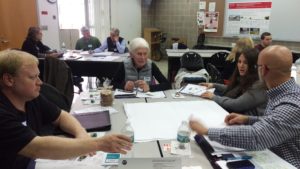Article and photos by Joseph Mish
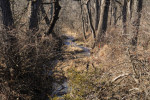
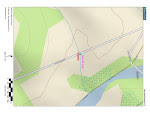
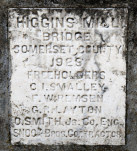
A thin blue line drawn on a map, comes to life in this photograph. A plaque, inset in a concrete bridge spanning the stream, constructed in 1923, a map showing a thin blue line depicting the stream and an image of the stream as it exists today just before it reaches the South Branch.
If all the water that ever flowed from the Raritan River drainage could be measured, its contribution to the depth of the ocean would be impressive. Think of that watershed as a collection agency for world’s oceans.
An aerial view of the Raritan River clearly shows its two main branches, the South Branch, and the North Branch. The South Branch draining more area than the North. The confluence of the North and South branch mark the beginning of the Raritan River.
A closer look reveals the larger tributaries which feed the main branches; Rockaway creek, Black River/ Lamington River and the Neshanic River, all of which are clearly noted on maps.
No less important, are the numerous smaller brooks and creeks whose contribution is significant and whose names may appear only on old maps or engraved on marble plaques set in the structures that bridge their banks; Peter’s brook, Chamber’s brook, Pleasant run, Prescott brook, Assiscong creek, Minneakoning creek, Holland brook and the First, Second and Third Neshanic rivers. Hoopstick, Prescott and Bushkill are lesser known streams, within plain view, that bear no identifying name.
There are dozens more minor streams whose names appear nowhere except on an obscure online list. Each one eventually feeds into the Raritan or its two main branches above their confluence. Knowing someone’s name is a sign of respect. Calling someone by the wrong name can be embarrassing. However, the sign that identifies the North branch of the Raritan as the Raritan River proper, has failed to embarrass those responsible for posting such signs.
Many smaller seeps and springs whose names have been lost to the ages, add to the accumulated flow. Driving along the Lamington, for instance, there are endless watery traces, arising from springs within the woods that empty into larger tributaries. Many are just moist creases worn through the soil over time, which collect rainwater and snow melt to supplement the downstream daily flow.
Maps show nameless springs, which make the cartographer’s final draft, as thin blue lines. Often, a network of converging shorter lines, each with a defined beginning, join to form larger streams like Pleasant run and Holland brook.
These obscure water sources fascinate me simply because their anonymity and remote location arouses curiosity. Their presence also represents a convergence of habitat types that attract birds and wildlife. Though they bear no labels to honor their faithful contribution to the next blue line and ultimate confluence, their importance should not be overlooked.
Many springs which appeared on old maps no longer exist, eliminated by construction of sewer lines or filled in. As maps are revised and generations fade, these streams exist only in a cartographer’s archive.
My appreciation for these disappearing blue lines was heightened when I recently discovered that as a kid, I walked over Slingtail brook every day on the way to school. At some point this little stream was diverted through a sewer line under the pavement. More amazing, even older residents had no memory of that stream whose name has been lost to the ages.
An extended winter freeze, preserving snow from a previous storm, beyond its expected stay, was interrupted by a thaw and heavy rain. The melting snow joined the torrential rain as it flowed over frozen ground to collect in every shallow crease leading to the river. The water’s velocity was enhanced by the decreasing gradient of deep well-worn pathways etched in the earth.
Where water barely trickled most of the year, a proportional biblical flood now ensued.
The banks of the successively larger streams barely contained the accumulation of water delivered from the network of anonymous thin blue lines. Acting as a single entity, the collection agency if you will, the Raritan River drainage, faithfully delivered its contribution of sweet water to the world’s salty oceans.

Cattail brook arises from the convergence of a network of bubbling springs, supplemented by runoff from rain and snow fall. It begins as hardly more than a trickle, directed by gravity, from the south facing ridge of the heavily forested Sourland mountains. The DNA extracted from a drop of water, taken from the deepest canyon in the ocean, would trace its lineage back to cattail brook through its genetic progeny. Cattail gives birth to Rock Brook, a tumultuous and moody stream that joins the more sedate Bedens brook on its way to the Millstone river. The Millstone brings its accumulated genetic material to blend with that of the Raritan to make a final contribution to the earth’s deep blue oceans.

We use our imagination as we await the technology that can trace the oceans DNA back up Cattail brook to show a single drop of morning dew that dripped from a box turtles face, was a critical contribution to the blue ocean we see via satellite images of the earth.
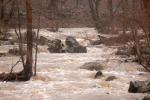
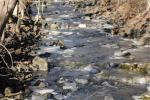
Rock brook derives its character from the influence of gravity which changes its mood from an idyllic mountain brook to a raging torrent.
Author Joe Mish has been running wild in New Jersey since childhood when he found ways to escape his mother’s watchful eyes. He continues to trek the swamps, rivers and thickets seeking to share, with the residents and visitors, all of the state’s natural beauty hidden within full view. To read more of his writing and view more of his gorgeous photographs visit Winter Bear Rising, his wordpress blog. Joe’s series “Nature on the Raritan, Hidden in Plain View” runs monthly as part of the LRWP “Voices of the Watershed” series. Writing and photos used with permission from the author.
Article and photos by Joe Sapia
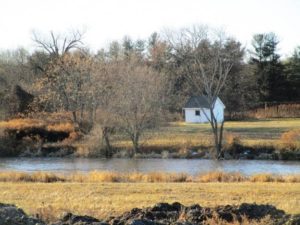
A farm outbuilding in Hopewell Township, Mercer County.
UPPER MILLSTONE RIVER EAGLE NEST: Last year’s pair of bald eagles, “Haliaeetus leucocephalus,” has returned to its nest along the Millstone River corridor on the boundary of Middlesex and Mercer counties. Last year, the nest fledged one eaglet. The state Endangered and Non-Game Species Program (within the Department of Environmental Protection’s Division of Fish and Wildlife) has named Anne Price, a professional naturalist and fellow Monroe, Middlesex County, resident, and me as the volunteer monitors for the nest. The eagles were still in pre-nesting phase, but we expect an egg or eggs to be laid any day now. More good news to follow next week. (In the 2017 state eagles report, http://www.state.nj.us/dep/fgw/ensp/pdf/eglrpt17.pdf, this nest is listed as No. 184.)
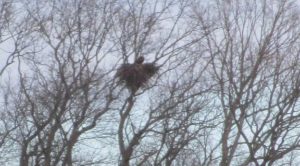
A bald eagle perched on the Upper Millstone River nest on the boundary of Mercer and Middlesex counties. This pair appears ready to lay an egg or eggs soon.
SNOWFALL: The Wednesday, January 17, snowfall in the part of Monroe between Jamesburg and Helmetta, Middlesex County, was about 1.0 inches, bringing the seasonal total to about 17.0 inches. (The seasonal average, measured at New Brunswick about 7.5 miles away, is 25.8 inches. So, we need only about 9 more inches to hit the average and we have about 3 months of snow time left.)
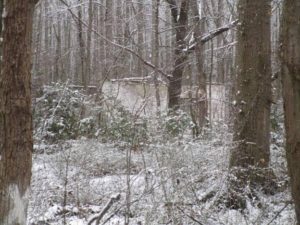
Snowy woods with an abandoned building on Federal Road in Monroe, Middlesex County.
SNOWFENCING: I have talked about snowfencing in open areas before and how it prevents drifting on roadways. Also, I have posted photos. But, perhaps, the post-snowfall scene best describes snowfencing, how snow is deposited on the downwind side. A photograph of the post-snowfall scene:
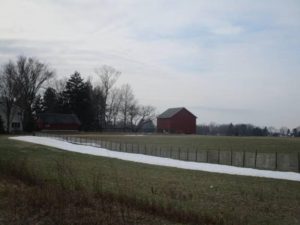
Here, on Main Street in Cranbury, Middlesex County, snow has deposited on the downwind side of the snowfencing. This same concept is used to contain blowing sand on beaches.
CANADA GEESE: I have been seeing a lot of Canada geese, “Branta canadensis,” on farmland, presumably helping themselves to leftover field corn in these fields. And I keep an eye out to see if there is anything else mixed in with these Canadas, perhaps a snow goose, “Chen caerulescens.”
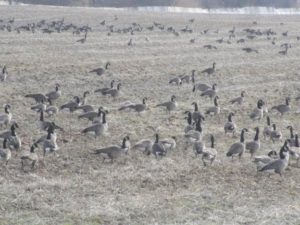
Canada geese on farmland in Cranbury, Middlesex County.
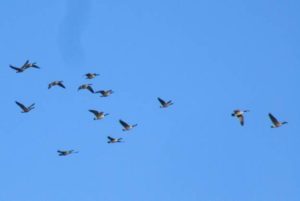
Canada geese flying in Hopewell Township, Mercer County.
BIRDS AROUND THE YARD: We have an incredible world of nature around us in New Jersey. We are at a prime location, where northern and southern animal and plant species meet. One easy thing to do is take time to view the birds in one’s yard. I feed them, using sunflower kernels/hearts nyger. (Last year, though, I stopped feeding birds in the summer, letting them serve as a natural pesticide in my yard. This year, I may extend this feeding ban beyond June, July, and August to a greater gardening period.)
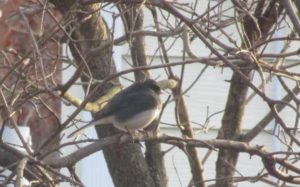
It is a “snowbird” – or dark-eyed junco, “Junco hyemalis” – but it is bundled up against the cold. This junco, in an oak, genus “Quercus,” in my sideyard, has its feathers fluffed to protect it against the cold.
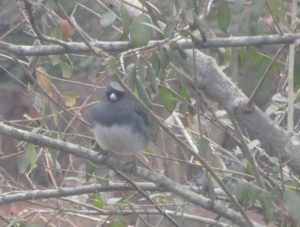
This photograph shows the “dark-eyed” in this dark-eyed junco. This bush in front of my living room window is a fun place to watch birds.
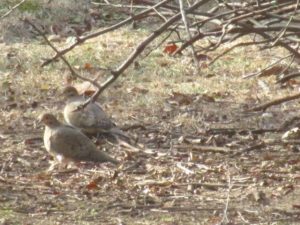
Mourning doves, “Zenaida macroura,” huddled under the flowering quince bush in my backyard.
COASTAL PLAIN BODIES OF WATER: The Jersey Midlands is divided into two geological provinces – the rolling and rocky Piedmont to the west and the flatland, either sandy or gravely, to the east. (The Coastal Plain can be divided into the Outer, or sandy, white soils of the Pine Barrens and beach, and the Inner, the darker, gravely soil conventional farming areas. For the sake of this story, we will talk of the Coastal Plain as one province.) Because of its flatness, there are few, if any, natural bodies of water on the Coastal Plain; Instead, they are human-made, often by dams holding back waterways. In Middlesex County, on the boundary of Helmetta, Monroe, and Spotswood, there is now-dry Lake Marguerite. It was formed by the damming of Manalapan Brook, but has been dry since the 1920s or so. The other day I shot photographs of its old dam.

The remnant of the Lake Marguerite dam on Daniel Road-10th Street on the boundary or Spotswood and Monroe, Middlesex County.

The circa 1906-1907 Lake Marguerite dam.
“OLD JERSEY”: As the Jersey Midlands develop, I am glad to run across “Old Jersey” remnants. Across the street from my house is one of them with an environmental twist – a “Prevent Forest Fires” sign. This sign might be the same one I have seen over all my 61 years. (Just to point out: There has been a different way of thinking on fire. For example, fire is good for the ecology of the Pine Barrens, such as where I live; But it is bad for people.)
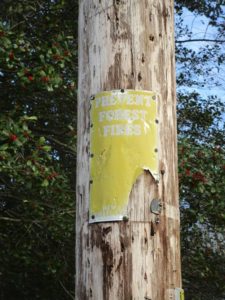
An old “Prevent Forest Fires” sign in my Monroe, Middlesex County, neighborhood.
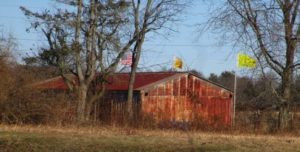
Another “Old Jersey” scene: a farm in Hopewell Township, Mercer County.
SKY VIEWS: This week’s sky views are from Monroe, Middlesex County, and the Manalapan-Freehold Township boundary, Monmouth County.

Monmouth Battlefield State Park on the boundary of Freehold Township and Manalapan, Monmouth County.

Monroe, between Applegarth and Wyckoff’s Mills.
ATLANTIC OCEAN TEMPERATURES: The Atlantic Ocean temperature in New Jersey ranged from about 36 to 37 degrees.
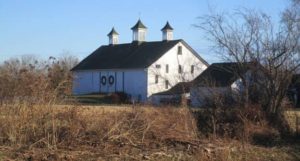
More farming from Hopewell Township Mercer County.
WEATHER: The National Weather Service forecasting office serving the Jersey Midlands is at http://www.weather.gov/phi/.
SUNRISE/SUNSET: For Sunday, January 21, to Saturday, January 27, the sun will rise about 7:10 to 7:15 a.m. and set about 5:05 to 5:10 p.m. For Sunday, January 28, to Saturday, February 3, the sun will rise about 7:05 a.m. to 7:10 a.m. and set about 5:10 p.m. to 5:20 p.m.

The crescent moon over Helmetta Pond, Middlesex County. The crescent moon is waxing toward the January 31 Full Snow Moon.

Ralph “Rusty” Richards, 85-years-old, a mentor of mine in the Pine Barrens around Helmetta, was buried this week in St. James Cemetery in the part of Monroe between Helmetta and Jamesburg, Middlesex County. As his obituary read, “He was an avid woodsman with an extensive knowledge of the local pine barrens….” I left this bough of pitch pine, “Pinus rigida,” the most common pine in the New Jersey Pine Barrens, on Rusty and his wife’s, Mona’s, gravestone. The cemetery is in my neighborhood and Rusty’s grave is a neighbor of my parents’s, Joe Sr. and Sophie Onda Sapia’s, grave. (My maternal family, the Onda-Poznanski family, has known the Richards family for 100 or so years.)
— Joseph Sapia
2018, January 21, Sunday,
A woodsman of the Pine Barrens of Helmetta
Joe Sapia, 61, is a lifelong resident of Monroe — in South Middlesex County, where his maternal family settled more than 100 years ago. He is a Pine Barrens naturalist and an organic gardener of vegetables and fruit, along with zinnias and roses. He draws inspiration on the Pine Barrens around Helmetta from his mother, Sophie Onda Sapia, who lived her whole life in these Pines, and his Polish-immigrant grandmother, Annie Poznanski Onda. He gardens the same backyard plot as did his Grandma Annie and Italian-American father, Joe Sr. Both are inspirations for his food gardening. Ma inspires his rose gardening. Joe is a semi-retired print journalist of almost 40 years. His work also is at @JosephSapia on Twitter.com, along with Facebook.com on the Jersey Midlands page.
Copyright 2018 by Joseph Sapia
Article by Quentin Zorn
My name is Quentin, and I am a junior at Rutgers studying environmental policy. Over the course of this semester, I have been interning with the Lower Raritan Watershed Partnership and have had the opportunity to work on a wide variety of projects relating to water quality issues. I participated in many stream cleanups, attended many exciting events such as the Raritan River Festival, got to contribute to several long-term art projects and learned a lot along the way. This experience has not only taught me a lot about watershed management, but also has broadened my way of thinking and strengthened my passion for combating environmental issues.
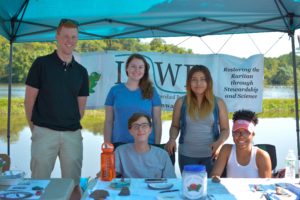
One of the more exciting projects I was able to participate in was teaching kids from the Plainfield Youth Center about water quality and watershed management, and to work on an art project with them. This was part of the Lower Raritan Watershed Partnership’s Project WADES Environmental Education curriculum. We started off by taking the kids to a nearby stream and training them in visual habitat assessments and how to notice what kinds of things can impair stream quality, such as nearby roads, maintained lawns and lack of riparian cover. We got to help build a foundation with these kids at a young age, which will help them understand and care about water quality issues as they grow up.
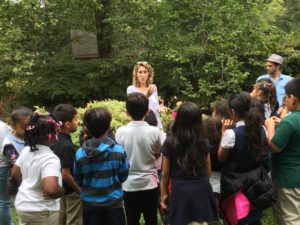
The art project we worked on with the kids was a lot of fun and interactive. Each kid selected a piece of trash found at a cleanup in the Lower Raritan Watershed, and then held that piece of trash in a container, which we would then fill with an algae-based mold called alginate.

The finished products were a bunch of unique sculptures of hands holding the trash.

When I was working on my own on this internship, I got to explore and contribute to several different datasets. I worked on a master database of every municipality in the Lower Raritan Watershed that contained a wide variety of information on each town’s environmental and development plans. I also worked with data from the New Jersey Department of Environmental Protection on different industries that have permits to pollute into the Raritan River, and I helped make this data more coherent and complete. This helped me understand what kind of information is important when considering water quality, and also my contributions helped make more complete and meaningful logs of data. It was really satisfying to see all this information come together and fulfilling to know that the public can access this data and learn what is going on in their watershed.
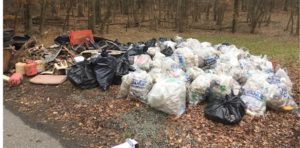
There were many cleanups of streams in the watershed throughout the duration of my internship, and I participated in as many as I could. The cleanups were far more rewarding than I anticipated them being. Arriving at any given cleanup gave me a feeling of hopelessness when I would see how much trash there was. I would think, “we can make this a little better, but it’s still going to be in a bad condition.” Every single cleanup I was surprised by how good of a job everyone did, and how great the area looked when we left. Seeing all of the trash piled up in the end was always shocking but felt good to have gotten it all out of the ecosystem.
Article and photos by Joe Sapia (except where noted)
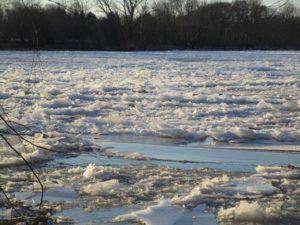
The Delaware River, iced-over Tuesday, January 2, at Washington Crossing — looking from Mercer County, New Jersey, to Bucks County, Pennsylvania, just upstream of the bridge.
SUB-FREEZING DAYS: After days of sub-freezing cold, how cold was it? Cold enough for a waterway – in this case, the mighty Delaware River — to freeze over.
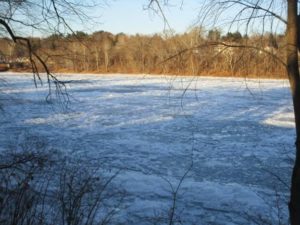
The frozen-over Delaware River Tuesday, January 2, at Washington Crossing, looking from Pennsylvania to New Jersey.

A woman maneuvers Main Street in Cranbury during the Thursday, January 4, snowfall.
SNOWFALL, JANUARY 4: This storm produced a wind-whipped, powdery snow. Snowfall totals reported by National Weather Service:
Burlington County: 3.4 inches at Cinnaminson to 7.5 inches in the Southampton area.
Hunterdon County: 1.9 inches at Readington to 5.8 inches in the Hampton area.
Mercer County: 4.0 inches in the Washington Crossing area to 6.6 inches in the Lawrence area.
Middlesex County: 4.5 inches in the South Brunswick area to 9.6 inches at Cheesequake.
Monmouth County: 9.0 inches at Keyport to 18.0 inches in the West Long Branch area.
Ocean County: 12.5 inches in the Brick area to 18.3 inches in the Berkeley area.
Somerset County: 3.0 inches in the Montgomery area to 5.8 inches in the Franklin area.
(These totals are for these specific stations and may not be complete highs and lows for the counties.)
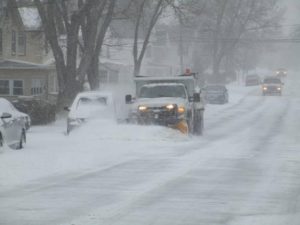
A snowplow pushes snow on Stockton Avenue in Jamesburg, Middlesex County, in the Thursday, January 4, snowfall.
SNOWFALL FOR THE SEASON: With the January 4 snowfall, my house in Monroe, Middlesex County, has had 16 inches of snow, so far this season. The seasonal average at New Brunswick, Middlesex County, or about 7.5 miles from my house, is 25.8 inches. The January 4 snowfall produced 7 inches at my house.
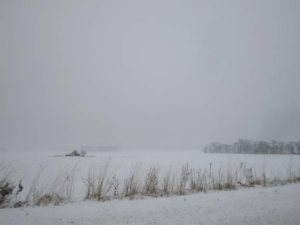
A wind-whipped, snowy field in Monroe, Middlesex County.
WALKING THE SNOWY WOODS: During the Thursday, January 4, storm, I set out from my house about 4:30 p.m., hitting the woods across the street, not wanting to pass up the pristine snowy woods. It was a brief walk, only about 45 minutes from shortly before sunset to shortly after. But I was glad I got to spend a few minutes shooting pictures of nature’s beauty and relaxing in the woods, before shoveling snow. (Weather conditions: Overcast, estimated temperature of 27 degrees, dew point of 5.5 to 6, wind sounding like a freight train.) I got thinking about this short time in the woods. Normally, I do not consider it a hike unless I do at least 3 miles. Perhaps I should re-focus and think about the mental part of the woods and try to get out there daily, even if for only a short time.
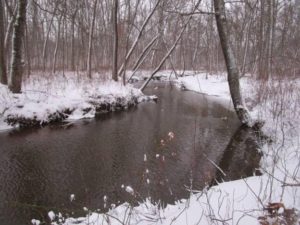
The Old Swimming Hole on Manalapan Brook in Monroe, Middlesex County.
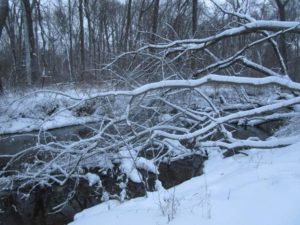
A snow-covered treefall on Manalapan Brook in Monroe, Middlesex County.
SNOW AND THE LAY OF THE LAND: Take advantage of any snow cover. Where there is no snow cover, the woods presents itself as a homogenous picture of earth tones or green leaves – or both. But add a snow-cover; or, better, snow-cover and snow clinging to vegetation; or better yet, snow-cover, snow clinging to vegetation, and foliage and the depth and roll of the land stand out.

The snow-dusted Pine Barrens around Helmetta, Middlesex County – here, specifically, an East Brunswick section of the Jamesburg Park Conservation Area. With the snow contrasting against the earth tones of the woods, it is easy to see the roll of the land.
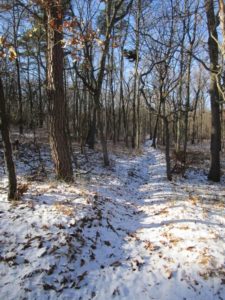
A firecut, plowed by the state Forest Fire Service before a controlled burn here in the Jamesburg Park Conservation Area, is easly seen, along with the rest of the lay of the land, thanks to snow contrasting with the woods’s earth tones.
VOICES FROM AFIELD, EAGLE: Patty Byrnes Lang of Monroe, Middlesex County, checked in with photographs of a bald eagle, “Haliaeetus leucocephalus,” she saw on the boundaries of Monroe, Cranbury/Middlesex County, and East Windsor/Mercer County. In New Jersey, bald eagles are “endangered,” or in immediate jeopardy, as breeders and “threatened,” meaning if conditions persist they could become endangered,” in general. Patty described one encounter, “I caught a glimpse of him in one of the trees on the left. We got to watch as he flew off the branch he was on, circled the field, and landed on another tree.” Based on its coloring, this is an adult. It could be one of the adults that had a nest last year nearby, along the Millstone River in Monroe. This is the time of year eagles begin working on nests.
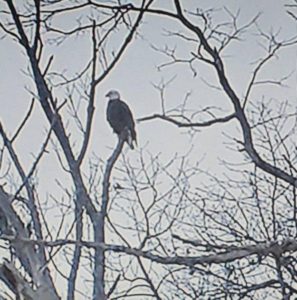
A bald eagle on the boundary of Middlesex and Mercer counties, along the border of Monroe/Middlesex, Cranbury/Middlesex, and East Windsor/Mercer. (Photo copyright 2017 by Patty Byrnes Lang)
VOICES FROM AFIELD, BLUEBIRD: Bob Kane of Cranbury, Middlesex County, checked in with a photograph of an eastern bluebird, “Sialia sialis,” taken in his town. This one is easily identifiable as a male, because of the bright coloring.

A male eastern bluebird at Cranbury, Middlesex County. (Photo copyright 2018 by Bob Kane)
RANCOCAS CREEK: The Rancocas Creek watershed is 360 square miles. It is the only major waterway that flows into the Delaware River from the Pine Barrens. And, despite being freshwater, has a tidal effect; The Delaware River has a tidal effect on its freshwater as far north as Trenton.
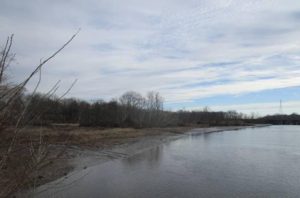
Low tide on Rancocas Creek, looking upstream on the boundary of Mount Laurel, Willingboro, and Westampton, all in Burlington County. Although this is freshwater, there is a tidal effect on the Delaware River and its tributaries as far north as Trenton.
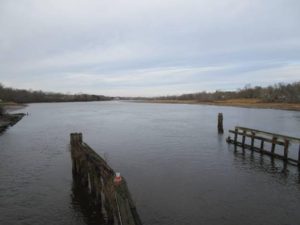
Rancocas Creek, looking downstream at the boundary of Mount Laurel, Willingboro, and Westampton, all Burlington County.
GARDEN WRITING COURSE: This spring, I will be teaching non-fiction writing again at the Princeton Adult School. This time, it will be “Garden Writing,” five sessions on Thursdays, 7 p.m. to 9 p.m., from March 22 to April 26. The class description: “Look at your garden and yard in a different way – through your words. Record your memories in the garden and yard through the essay and vignette. This writing-intensive course has weekly take-home assignments, with the instructor returning critiqued papers. Students will learn writing components, outlining, grammar, style, interviewing, and the importance of resources such as dictionaries and stylebooks – with all assignments focusing on our vegetables, flowers, yards – or afield, if you wish. In-class discussion will cover good examples turned in by students, common problems, and concerns. Feel free to use the class to write a chapter a week of a dream project, work on getting published, keep a journal, or just have fun.” The class costs $99. Enrollment at http://www.ssreg.com/princeton/classes/classes.asp?catID=3679.
ATLANTIC OCEAN TEMPERATURES: The Atlantic Ocean temperature at in New Jersey on the January 6-7 weekend ranged from about 29 to 30 degrees.
WEATHER: The National Weather Service forecasting office serving the Jersey Midlands is at http://www.weather.gov/phi/.
SUNRISE/SUNSET: For Sunday, January 7, to Saturday, January 13, the sun will rise about 7:20 a.m. and set about 4:45 to 4:50 p.m. For Sunday, January 14, to Saturday, January 20, the sun will rise about 7:15 to 7:20 a.m. and set about 4:55 to 5 p.m.
PENNSYLVANIA FARM SHOW: The Pennsylvania Farm Show continues through Saturday, January 13. It is a real-deal show of farming life, not faux farming. So, it has animals, tractors, food preparation, food to buy, gardening displays, and exhibitions. Visitors can get up close to it all. And check out the butter sculpture! (Unfortunately, I will miss the show this year. I had plans to go Wednesday with friends Jimmy and Kathy Krygier of Krygier’s Nursery in South Brunswick, Middlesex County, but work called. I am disappointed, because I look forward to this show.) More information at http://www.farmshow.pa.gov.
COVERING THE WEATHER: During my 31 years as a reporter at the Asbury Park Press, I never saw fellow Metro reporters whine so much about covering something than about weather stories. Me, just the opposite. I loooooooved weather stories. Still do. Was out most of Thursday, January 4, chasing the snow.

Joey on the job, here Tuesday, January 2, photographing the iced-over Delaware River at Washington Crossing, Mercer County.. (Photo copyright 2018 by Pamela B. Roes)
Joe Sapia, 61, is a lifelong resident of Monroe — in South Middlesex County, where his maternal family settled more than 100 years ago. He is a Pine Barrens naturalist and an organic gardener of vegetables and fruit, along with zinnias and roses. He draws inspiration on the Pine Barrens around Helmetta from his mother, Sophie Onda Sapia, who lived her whole life in these Pines, and his Polish-immigrant grandmother, Annie Poznanski Onda. He gardens the same backyard plot as did his Grandma Annie and Italian-American father, Joe Sr. Both are inspirations for his food gardening. Ma inspires his rose gardening. Joe is a semi-retired print journalist of almost 40 years. His work also is at @JosephSapia on Twitter.com, along with Facebook.com on the Jersey Midlands page.
Copyright 2017 by Joseph Sapia
LRWP “Voices of the Watershed” contributor Joe Sapia will be teaching non-fiction writing during the spring 2018 semester at the Princeton Adult School. This semester the theme is “Garden Writing” – writing essays or vignettes about garden, yard, greenhouse, or afield. A description of the course is below:
Look at your garden and yard in a different way – through your words. Record your memories in the garden and yard through the essay or vignette. This writing-intensive course has weekly take-home assignments, with the instructor returning critiqued papers. Students will learn writing components, outlining, grammar, style, interviewing, and the importance of resources such as dictionaries and stylebooks – with all assignments focusing on our vegetables, flowers, yards – or afield, if you wish. In-class discussion will cover good examples turned in by students, common problems, and concerns. Feel free to use the class to write a chapter a week of a dream project, work on getting published, keep a journal, or just have fun.
Garden Writing at the Princeton Adult School,
http://www.ssreg.com/princeton/classes/description.asp?id=106510
http://www.ssreg.com/princeton/classes
Instructor: Joseph Sapia.
Joe Sapia has been a professional non-fiction writer for almost 40 years. He is a retired reporter from the Asbury Park Press. He, now, freelances, including writing a weekly blog, “Garden and Afield in the Jersey Midlands,” along with being an instructor at the Rutgers University Plangere Writing Center. He is an organic vegetable gardener and zinnia grower, using the same 60-year-plus plot used by his Italian-American father and Polish-immigrant grandmother. Joe is a member of the Rutgers Master Gardeners program/Middlesex County.
Joe can answer questions at SnuffTin@aol.com.
On November 17 the Lower Raritan Watershed Partnership joined with NOAA to co-host a day-long workshop: “Introducing Green Infrastructure for Coastal Resilience”. This workshop, designed for planners, engineers and municipal leaders not yet familiar with GI for coastal resilience, brought in more than 50 participants from the Lower Raritan Watershed and throughout New Jersey. It was a great event!
Workshop participants brainstorm ways to implement Green Infrastructure in their communities
Many thanks to everyone who joined us for the workshop, with special thanks to our speakers: Lauren Long (NOAA), Toby Horton & Jeremiah Bergstrom (Rutgers Cooperative Extension), John Trucsinski (The Nature Conservancy), Linda Weber (Sustainable Jersey) and Carter Craft (Consulate General of the Netherlands).
Tobiah Horton (Rutgers Extension), Lauren Long (NOAA) and Carter Craft (Consulate General of the Netherlands) discuss local resilience responses
The workshop was timed to coincide with the 5th anniversary of Superstorm Sandy. We saw this anniversary as an opportune moment to reflect on successes in implementing GI thus far, as well as to frame challenges, solutions and opportunities for future GI interventions. Of course this work is just beginning. The LRWP, NOAA and Rutgers Marine Sciences are discussing how to continue the conversation in 2018. Stay tuned! For now, please see conference handouts, presentations, and additional resources below.
Participant Agenda:
Conference Handouts:
Presentations:
Notes:
Additional Resources:
Article and photos by Joe Sapia
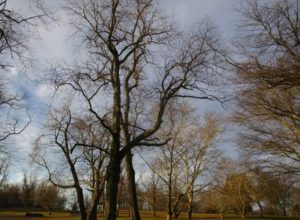
Soft morning sunlight contrasts with threatening skies at the high ground of Thompson Park in Monroe, Middlesex County.
A popular winter activity for generations at Thompson Park is sledding from the high ground toward the low ground around “Jamesburg Lake” (properly Lake Manalapan). The 30-acre lake is formed by the damming of Manalapan Brook at Jamesburg. Remember, there are few, if any, natural bodies of water on the Coastal Plain.

Sledding at Thompson Park in Monroe, Middlesex County, via my 2001 folk art Christmas card.
SNOWFALL: The Saturday, December 30, snowfall of 1.0 inch at my house in the part of Monroe between Helmetta and Jamesburg, Middlesex County, brought the season’s total to 9.0 inches. The seasonal average for New Brunswick, Middlesex County, about 7 miles away, is 25.8 inches. Elsewhere in the Midlands, according to the National Weather Service, with these readings based on what had been reported by reliable spotters at the end of the snowfall and perhaps not comprehensive: Burlington County: a high of 2.5 inches at Florence to a low of 1.5 inches at Moorestown; Hunterdon County: 1.0 inch in Lebanon to .8 inches at Whitehouse Station; Mercer County: 3.2 inches in Hamilton to 2.5 inches in Ewing; Monmouth County: 2.8 inches in the Howell area to .9 inches in Shrewsbury; Somerset County: 1.0 inch in Basking Ridge to .8 inches in Bridgewater; Ocean County: 3.3 in Jackson to 1.5 inches in Toms River.
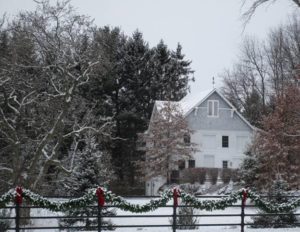
Main Street in Cranbury, Middlesex County, in the Saturday, December 30, snowfall.
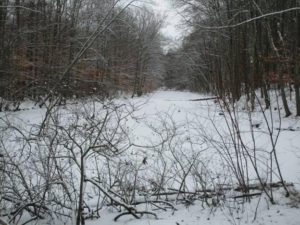
Iced-over and snow-covered Devil’s Brook on the boundary of Plainsboro and South Brunswick, Middlesex County.
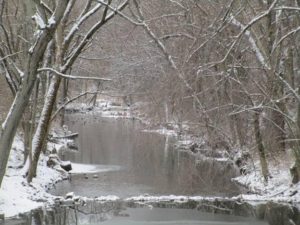
Cranbury Brook as it drains Brainerd Lake (“Cranbury Lake’) in Middlesex County.
SAFE ICE: This time of year, and especially in the hard freeze the Jersey Midlands is in the midst of, we may be tempted to walk out on ice or go skating on it. Be careful! My rule of thumb is the ice must be at least 4-inches-thick. But various factors could come into play, such as warming temperatures, honey-combing, and running water. So, additionally, I look for crystal clear ice or blue-white ice. I am careful of melting ice, snow insulating ice, channels that may run through bodies of water, and fragile ice where water meets land or vegetation.
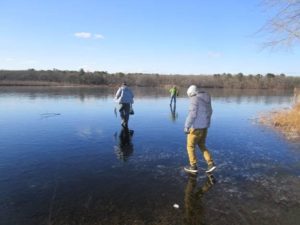
Anglers on an iced-over Helmetta Pond.
ICE SAFETY: If ice is breaking underneath, displace your weight by lying flat. For would-be rescuers, follow this order: throw (a line or flotation device), row (a boat to the person), go (yourself only as a last resort). Probably the soundest advice is to immediately seek help from expert rescuers.
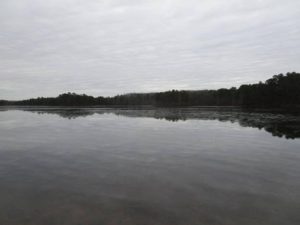
Prospertown Lake in Jackson, Ocean County. The lake is at the northern extreme of the main Pine Barrens.
SWAMP-WALKING: With the sub-freezing high temperatures for an extended period, this is what I look for — a good freeze of the swamps, allowing access to otherwise difficult places to get to. I love swamps!
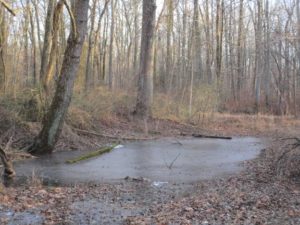
An iced-over wet area in the Manalapan Brook floodplain in Monroe, Middlesex County.
SWAMP-WALKING, No. 2: I started off into the woods across the street from my house – in the Pine Barrens of Monroe, Middlesex County – to do some swamp-walking in the Manalapan Brook floodplain. I did do some, but I got sidetracked when I noticed the abundance of winterberry, genus “Ilex.” I did not get around to making a Christmas wreath or swag, which I decorate with winterberry, but I wound up gathering winterberry to display on its own. I came home with a nice bundle. (To conserve, I broke only one branch from each selected bush.)
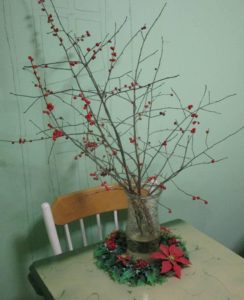
Winterberry from the swamp hardwood forest of the Manalapan Brook floodplain on display on my antique kitchen table.
SNOW GEESE: I finally saw some snow geese, “Chen caerulescens,” down from the Arctic as I was driving along the Mercer County-Middlesex County boundary on the border of East Windsor, Cranbury, and Monroe. They were easy to identify by their white bodies and black-tipped wings. There were only a few, rather than a flock. I took a few minutes to see if they were joining a flock on some farmland, but I was going to work and had limited time, finding nothing in my quick search.
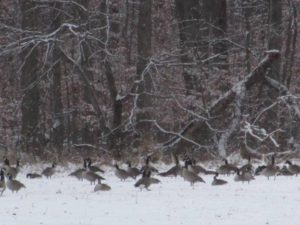
Canada geese, “Branta Canadensis,” is a snow-covered field in South Brunswick, Middlesex County.
ATLANTIC OCEAN TEMPERATURES: The Atlantic Ocean temperature at Sandy Hook on December 30-31 weekend ranged from about 30 to 35 degrees.
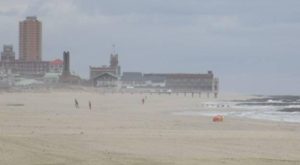
A quiet December Atlantic Ocean beach, looking from Avon-by-the-Sea to Asbury Park, Monmouth County.
MOON: The next full moon, the Full Moon After Yule, is January 1, New Year’s Day.
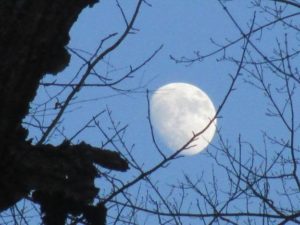
The near-full moon over the swamp hardwood forest of the Manalapan Brook floodplain in Monroe, Middlesex County.
SUNRISE/SUNSET: For Sunday, December 31, to Saturday, January 6, the sun will rise about 7:20 a.m. and set about 4:35 to 4:40 p.m. For Sunday, January 7, to Saturday, January 13, the sun will rise about 7:20 a.m. and set about 4:45 to 4:50 p.m.
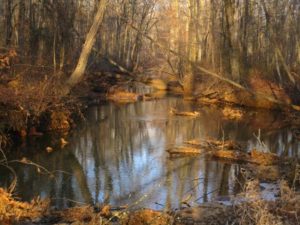
Soft sunlight on Manalapan Brook in Monroe, Middlesex County, as it flows toward Helmetta and Spotswood, also in Middlesex County.
Joe Sapia, 61, is a lifelong resident of Monroe — in South Middlesex County, where his maternal family settled more than 100 years ago. He is a Pine Barrens naturalist and a gardener of organic vegetables and fruit, along with zinnias and roses. He draws inspiration on the Pine Barrens around Helmetta from his mother, Sophie Onda Sapia, who lived her whole life in these Pines, and his Polish-immigrant grandmother, Annie Poznanski Onda. He gardens the same backyard plot as did his Grandma Annie and Italian-American father, Joe Sr. Both are inspirations for his food gardening. Ma inspires his rose gardening. Joe is a semi-retired print journalist of almost 40 years. His work also is at @JosephSapia on Twitter.com, along with Facebook.com on the Jersey Midlands page.
Copyright 2017 by Joseph Sapia
Article and photos by Joe Sapia
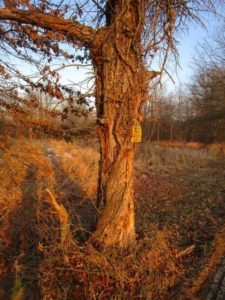
Soft, end-of-the-day sunlight bathes this tree and field on the Pennington-Hopewell Township border, Mercer County. Notice the thick vine – poison ivy, “Toxicodendron radicans” – climbing the tree.
DRIVE-BY NATURALIST, GREAT BLUE HERON: As I was passing Carnegie Lake, which is in the area of Princeton, Mercer County, and Kingston, Somerset-Middlesex counties, I figured I would shoot a photograph of the winter-quiet lake. Quiet? Wrong! As I arrived, a great blue heron, “Ardea herodias,” flew from left to right, landing at the lake. I heard a squawk or squawks, with this heron and another confronting each other, perhaps because these solitary hunters of fish and other aquatic life did not want to share a territory. One flew off, while the other stayed put, providing a subject for my photographs.

As I arrived at Carnegie Lake on the Princeton, Mercer County-Kingston, Middlesex-Somerset counties border, a great blue heron flew in.
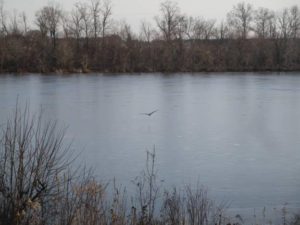 Then, there was a confrontation between two great blues, with one flying off.
Then, there was a confrontation between two great blues, with one flying off.

Remaining was one blue heron, who cooperated nicely for photographs.
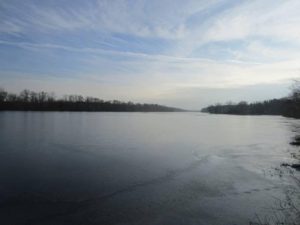
As for the winter calm of Carnegie Lake, it, otherwise, was there.
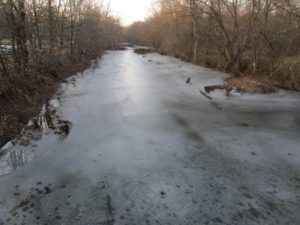
STONY BROOK: Stony Brook meanders for about 22 miles from the Ringoes area of Hunterdon County to the Princeton area of Mercer County, where it empties into the Millstone River. The brook drains approximately 65 square miles.
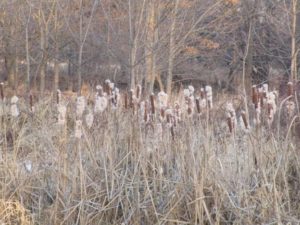
Punks, or cat-tails, genus “Typha,” with their fluffing-out seed heads, in the Stony Brook floodplain in the Pennington-Hopewell Township area, Mercer County.
IF YOU CANNOT GET TO THE ECOSYSTEM, BRING THE ECOSYSTEM TO YOU: Two geological provinces comprise the Jersey Midlands, the rolling hills and rocky Piedmont to the west and the flat, either gravelly or sandy, Coastal Plain to the east. Drive along the flat farmland on the Cranbury-Plainsboro border in Middlesex County and look west to the Princeton area hills in Mercer County, for example, and one would be looking from the Coastal Plain to the Piedmont. So, I was driving through the Pine Barrens around Helmetta and noticed a red shale pile of dirt, dumped on the side of the road in the Jamesburg Park Conservation Area, operated by the Middlesex County Parks and Recreation. Dumping! But this one takes the cake, the apparent dumping of Piedmont fill dirt in a sandy soil area of the Coastal Plain. Back up a truck alongside a road and dump fill dirt that you do not need! I take this as a personal affront because this is my home woods, which my maternal family has walked for more than 100 years, and in Jamesburg Park, where I am a volunteer of several years. The progress of dumping: litter to household debris to a different ecosystem!
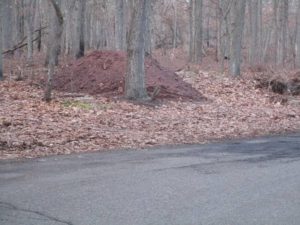
An illegally dumped pile of fill dirt, apparently Piedmont soil dumped in the Coastal Plain of the Pine Barrens around Helmetta, Middlesex County.
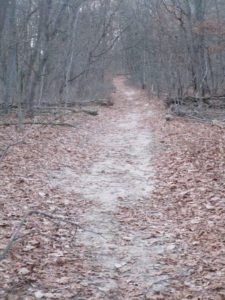
A Jamesburg Park Conservation Area trail of native white, sandy Pine Barrens soil near the dumped load of fill.
SNOW GEESE: I have not noticed any snow geese, “Chen caerulescens,” down from the Arctic. Bob Eriksen, a retired state Division of Fish and Wildlife biologist, checked in from just outside the Midlands in Warren County, saying, “Snow geese arrived, here, later than usual. Huge flocks came in overnight last Wednesday into Thursday morning December 13-14.”
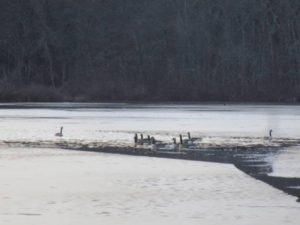
Canada geese, “Branta Canadensis,” on Helmetta Pond, Middlesex County.
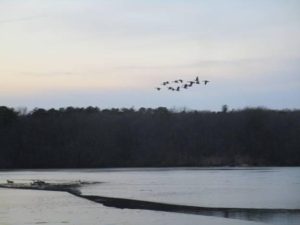
CANADA GEESE: I still stop to look at honking Canada geese, “Branta Canadensis,” in flight. And I get a bigger kick, perhaps, watching them land. While at Helmetta Pond, I noticed geese coming into the lake from the west, then swinging wide to the north and circling in for their landing. What a sight!
WINTER SOLSTICE: With the passing of the Winter Solstice on Thursday, December 21, daylight is increasing.
SNOWFALL TO DATE: To date, 8.0 inches at the Jamesburg-Helmetta area of Middlesex County. In this area, specifically New Brunswick, Middlesex County, the average seasonal total is 25.8 inches.
WEATHER: National Weather Service forecasting, along with other information, for the Jersey Midlands is at http://www.weather.gov/phi/.
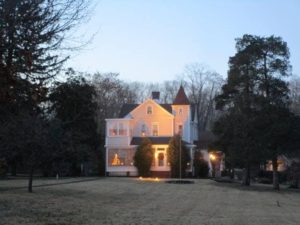
Merry Christmas from Helmetta. Here, the old Clemons house, one of the mansions associated in the 20th Century with the George W. Helme Snuff Mill — in this case, belonging to one of the mill’s upper level managers. According to house owner Carol Bohinski, “The Clemons mansion was built in 1890 by Arthur Clemons, brother-in-law to George W. Helme. Helme’s grandson, Arthur Helme Clemons, was a Helme Company President.”
Joe Sapia, 61, is a lifelong resident of Monroe — in South Middlesex County, where his maternal family settled more than 100 years ago. He is a Pine Barrens naturalist and a gardener of organic vegetables and fruit, along with zinnias and roses. He draws inspiration on the Pine Barrens around Helmetta from his mother, Sophie Onda Sapia, who lived her whole life in these Pines, and his Polish-immigrant grandmother, Annie Poznanski Onda. He gardens the same backyard plot as did his Grandma Annie and Italian-American father, Joe Sr. Both are inspirations for his food gardening. Ma inspires his rose gardening. Joe is a semi-retired print journalist of almost 40 years. His work also is at @JosephSapia on Twitter.com, along with Facebook.com on the Jersey Midlands page.
Copyright 2017 by Joseph Sapia
In November the New Brunswick Community Arts Council invited the Lower Raritan Watershed Partnership to participate in the inaugural “Windows of Understanding: We see through Hate” project. Windows of Understanding seeks to:
• Counteract the negativity and hate perpetuated in the headlines – by installing community art interventions that illustrate the compassion and love being exercised around us.
• Promote awareness about the vast array of social justice issues being addressed in New
Brunswick, connecting organizations with the wider community and each-other.
• Transform our “Main Street” spaces into literal windows of understanding.

The LRWP was paired with Kim’s Bike Shop (111 French St, New Brunswick, NJ 08901). Working with Kim’s and our coLAB Arts National Endowment for the Arts resident artist Jamie Bruno, the LRWP has developed “Listen to your neighbor, listen to the land” – which will be installed at Kim’s from January 15-February 28. “Listen to your neighbor, listen to the land” reflects the way the LRWP sees through hate as well as the way we hope to connect to our communities. The installation incorporates shoes filled with soil and plants. The shoes represent people, travel, and change. The soil represents our origins in the land.
From Jamie Bruno’s artist statement:
Across religion, race and culture we all spring from the earth and its water and soil. The plants give hope for survival and sustenance: hope to grow new roots and make new connections. The title asks the viewer to listen to their neighbors over the din of every day life. Our neighbors are people who live near us. People who live on the land we live on, yet whose stories we often do not know. In urban environments it can be difficult to know land too, yet she is everywhere: Under the pavement, in the water we drink, in the air we breathe.
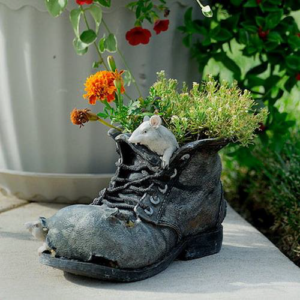 • The shoes represent the human element, the “neighbor” through travel, labor and economic change in addition to empathetic connection across class, race and culture; an admonition to “walk in another’s shoes.”
• The shoes represent the human element, the “neighbor” through travel, labor and economic change in addition to empathetic connection across class, race and culture; an admonition to “walk in another’s shoes.”
• The soil represents land: absorption, filtration, and contamination. Soil health effects human health though the quality of our fruits and vegetables as their roots gather nutrients and the quality of the water in our watersheds as water either filters slowly through healthy soil becoming clean or flows quickly above compacted soil carrying waste.
• The plants represent the hope to grow new roots in new places and to make new connections. Plants store and slow water as it moves through the landscape, further cleaning it, thereby increasing the landscapes inherent value to local wildlife and to neighbors, whether they pass through or decide to stick around and plant their own seeds.
The LRWP and Kim’s invite you to join us from 2-4 PM on Monday January 15, 2018 for the “unveiling” of “Listen to your neighbor, listen to the land” and for refreshments. We will be outside in front of the store planting milkweed for participants to take home, and handing out seed packets for summer gardens.
For more information contact Jamie Bruno: jamie@colab-arts.org
Article and photos by Joe Sapia
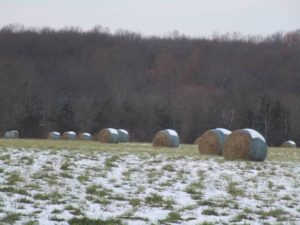
Fall meets winter with rolls of hay awaiting harvest on snow-covered farmland on the Princeton Ridge in Hopewell Township, Mercer County. The Princeton Ridge is one of three well-known pieces of hilly ground just north of downtown Princeton, the other two being Sourland Mountain and the Kingston Ridge.
SEASON’S FIRST SNOWFALL: My house in Monroe, Middlesex County, got its first snowfall of the season, this week – actually three snowfalls! The individual totals were December 9-10, Saturday-Sunday, 5.0 inches; December 13-14, Wednesday-Thursday, 1.5 inches; and December 15, Friday, 1.5 inches. All told, 8.0 inches. In my area, specifically New Brunswick, the average seasonal total is 25.8 inches.
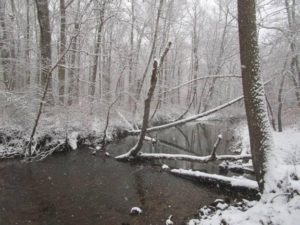 Snow falls along Manalapan Brook in Monroe, Middlesex County, during the season’s first snowfall, December 9-10, Saturday-Sunday. This locale is only a few hundred feet from my front door and I remember walking to this part of “The Brook” with my father when I was about 4-years-old, or more than 55 years ago.
Snow falls along Manalapan Brook in Monroe, Middlesex County, during the season’s first snowfall, December 9-10, Saturday-Sunday. This locale is only a few hundred feet from my front door and I remember walking to this part of “The Brook” with my father when I was about 4-years-old, or more than 55 years ago.
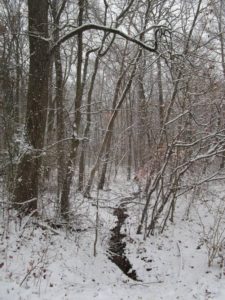
A stream cuts its way through the Manalapan Brook floodplain in Monroe, Middlesex County, during the first snowfall, December 9-10, Saturday-Sunday. This locale, at the bottom of my street, is what I have always known as “The Swamp.”
SNOWFENCING: As we travel through the Jersey Midlands, we may see snow-fencing in place to prevent drifting across roadways. The idea is to get the fencing up before it snows and hope it does not snow after farmers need to get in their fields for spring plowing or, that is, before it ends snowing for the season.
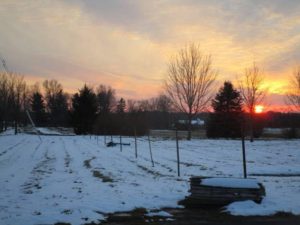
In Hopewell Township, Mercer County, this snow-fence was not up in time for the December 9-10, Saturday-Sunday, snowfall. Stakes in place, yes. Actual fencing, no.
GEMINID METEOR SHOWER: The Geminid Meteor Shower on the Wednesday-Thursday, December 13-14, overnight was a washout for me because of cloudy skies. More disappointing, because during that overnight, I was driving home from Baltimore and was hoping to be entertained for 2-1/2 to 3 hours. But that was a snowy night, so the viewing was not to be. Did anybody get lucky and see meterors?
‘SNOWBIRDS’ IN THE GARAGE: As I work in the yard or go between my house and my Jeep, I often leave the garage doors open. Occasionally over the years, I find a bird in the garage – seemingly always a “snowbird,” or dark-eyed junco, “Junco hyemalis,” birds that travel from as far away as Canada to stay from fall to spring. Most recently, I found one in the garage this week. Why seemingly always a snowbird in the garage? I do not know. Any thoughts?

A snowbird sits on top of my backyard birdfeeder while snow falls Friday, December 15, in Monroe, Middlesex County. American holly, “Ilex opaca,” is in the foreground.
AROUND THE BACKYARD: I sitting at my desk, in a corner room with windows facing north from the side of the house and facing west into the backyard, when I heard a wheezing call. A hawk? I looked into the backyard and saw no birds around the feeder or elsewhere in the backyard. However, I did notice a squirrel, “Sciurus carolinensis,” on the pole holding the feeder. The squirrel was frozen in place, facing downward, or in fleeing position. Yes, I thought, that probably was a hawk I heard. When the predator is around, the lucky prey flees.
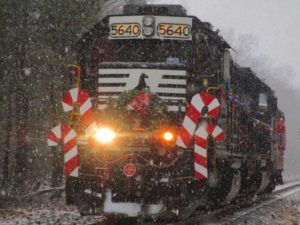
The annual ConRail Santa Train rumbled through Monroe, Middlesex County, this time while it is snowing December 9, Saturday. The Santa Train is especially fulfilling to me because it is a tradition of about 35 years; passes on railroad tracks my family has lived along for more than 100 years, as close as bordering the property and as far as my house, a quarter-mile; and, I have loved the freights on this line since my childhood days of the mighty Pennsylvania Railroad. It passes on the former line of the Camden-Amboy Railroad, the first railroad in the country, in the early 1830s, to replace equine power with mechanical power.
VOICES FROM AFIELD, CHRISTINE DENNELER: Christine Denneler, one of my Pine Barrens mentors over the last 35 years, checked in, regarding hunting: “Since most of my husband’s family is gone, hunting is not talked about at the holiday table as it was in the old days. (Late husband) Bill was not an avid hunter as was his grandpop, but he and his father liked the camaraderie.” (Chris has been a backbone of hiking in the Outdoor Club of South Jersey, www.ocsj.org, for decades. To go on a Chris Denneler hike is to learn the Pine Barrens.)
TONY’S FARM AND GARDEN CENTER: I was driving home from South Jersey and took advantage of passing Tony’s Farm and Garden Center — started and run by the Ciaccio family in Robbinsville, Mercer County, since 1946 — by stopping in. I have been patronizing Tony’s – in my case, for houseplants, vegetable plants, and garden supplies – for decades. It is one of my favorite places in the Jersey Midlands. Not only was it holding on to the 2017 gardening season, but it was decked out for Christmas. So, I bought a Christmas cactus – my first shot at one, so let us see if I can keep it alive – and two devil’s ivy houseplants – which even I have a hard time killing. (A shout-out to Ciaccio family members, especially young Tony, for their quality products and service and friendliness. Tony’s is one of my main sources for gardening information.)

Wreaths at Tony’s Farm and Garden Center in Robbinsville, Mercer County.

Poinsettias at Tony’s Farm and Garden Center
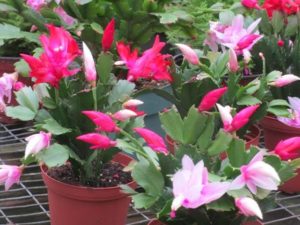
Christmas cactuses at Tony’s Farm and Garden Center.
VOICES FROM AFIELD, PRISCILLA “PEPPY” BATH: Outdoorswoman Priscilla “Peppy” Bath checked in on hiking Jake’s Branch County Park in the Ocean County Pine Barrens: “I have never before been to the park and it is beautiful with many well-marked trails. We hiked the Blue (Trail) 4-mile hike. Alongside of the trail were many patches of trailing arbutus (“Epigaea repens”) and also turkey beard (“Xerophyllum asphodeloides”). Neither was in bloom, but I will go back in the spring and see the beautiful flowers.” More information on Jake’s Branch Park is available at http://www.oceancountyparks.org/ContentPage.aspx?ID=0694b294-986f-46e6-a679-d03ac775c176.
‘SNOW GEESE’: This time of year, we can expect to see snow geese, “Chen caerulescens,” down from the Arctic tundra – perhaps flying by, noticeable by their white color and black-tipped wings, or in farm fields. So far, I have not seen any, but hope to. (The species also has a dark version, or the “blue goose.”)
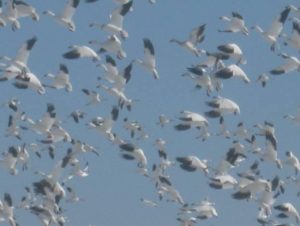
I took this photo of snow geese a few years ago on farmland along the Cranbury-Plainsboro boundary in Middlesex County. Here, their white bodies and black wingtips, which provide easy identification, are easily seen.
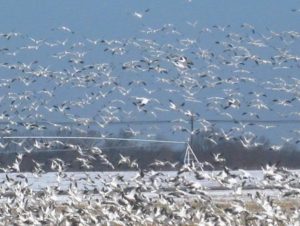
Another photograph of snow geese from a few years ago. Here, both in flight and in a cornfield.
TUNDRA SWANS: Tundra swans, “Cygnus buccinators” – New Jersey’s only native swan — are in the area. They, too, are cold-weather visitors from the Arctic tundra. My favorite place to see them is Whitesbog, in the main Pine Barrens and part of Brendan T. Byrne State Forest. Here is a story about Tundra Swan No. 207, spotted this season at Whitesbog, http://birdquiz.net/t207-2017/.
THE QUIET OF WINTER: In the winter, with many people staying inside in the warmth, the outdoors has a quiet solitude in many spots. Two places I visited during the week come to mind, the Delaware and Raritan Canal, where I visited the canal in Franklin Township, Somerset County, and the confluence of Crosswicks Creek and the Delaware River at Bordentown City, Burlington County.
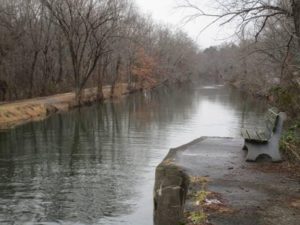
The Delaware and Raritan Canal at Griggstown in Franklin, Somerset County.

Crosswicks Creek at Bordentown City, Burlington County.
ATLANTIC OCEAN TEMPERATURES: The Atlantic Ocean temperature at Sandy Hook on December 17, Sunday, ranged from about 36 to 40 degrees.
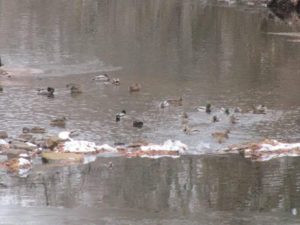
Mallard ducks, “Anas platyrhynchos,” on Cranbury Brook in Cranbury, Middlesex County.
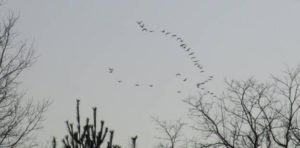
A familiar sound is the honking, then sighting, of Canada geese, “Branta Canadensis,” I captured this photograph from my backyard in Monroe, Middlesex County.
SUNRISE/SUNSET: For Sunday, December 17, to Saturday, December 23, the sun will rise about 7:15 to 7:20 a.m. and set about 4:25 p.m. For Sunday, December 24, to Saturday, December 30, the sun will rise about 7:20 a.m. and set about 4:35 to 4:40 p.m.
WINTER SOLSTICE: The Winter Solstice, or the day with the least amount of daylight, is December 21, Thursday. The sun rises about 7:17 a.m. and sets about 4:35 p.m. After, the amount of daylight grows until June 21, the “longest day” of the year.
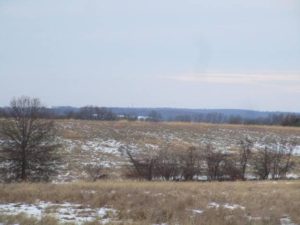
A view of Sourland Mountain, which is on the boundary of Somerset, Mercer, and Hunterdon counties, in the background across the farmland. This is as seen from the Princeton Ridge, Mercer County.
WEATHER: National Weather Service forecasting, along with other information, for the Jersey Midlands is at http://www.weather.gov/phi/.
UNEXPECTED WILDLIFE REFUGE SEEKS VOLUNTEERS: Our friends at the Unexpected Wildlife Refuge, just south of the Jersey Midlands in Gloucester County, seek volunteers to patrol the property to keep hunters off until at least the end of January. If interested, contact the refuge, http://unexpectedwildliferefuge.org/.
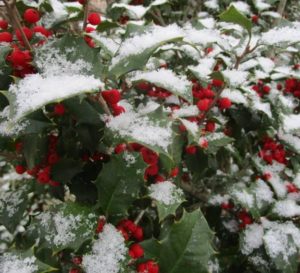 Snow clings to an American holly, “Ilex opaca,” in my backyard in Monroe, Middlesex County, from the December 9-10, Saturday-Sunday. This was the first snowfall of the season at my house.
Snow clings to an American holly, “Ilex opaca,” in my backyard in Monroe, Middlesex County, from the December 9-10, Saturday-Sunday. This was the first snowfall of the season at my house.
Joe Sapia, 61, is a lifelong resident of Monroe — in South Middlesex County, where his maternal family settled more than 100 years ago. He is a Pine Barrens naturalist and a gardener of organic vegetables and fruit, along with zinnias and roses. He draws inspiration on the Pine Barrens around Helmetta from his mother, Sophie Onda Sapia, who lived her whole life in these Pines, and his Polish-immigrant grandmother, Annie Poznanski Onda. He gardens the same backyard plot as did his Grandma Annie and Italian-American father, Joe Sr. Both are inspirations for his food gardening. Ma inspires his rose gardening. Joe is a semi-retired print journalist of almost 40 years. His work also is at @JosephSapia on Twitter.com, along with Facebook.com on the Jersey Midlands page.
Copyright 2017 by Joseph Sapia













































